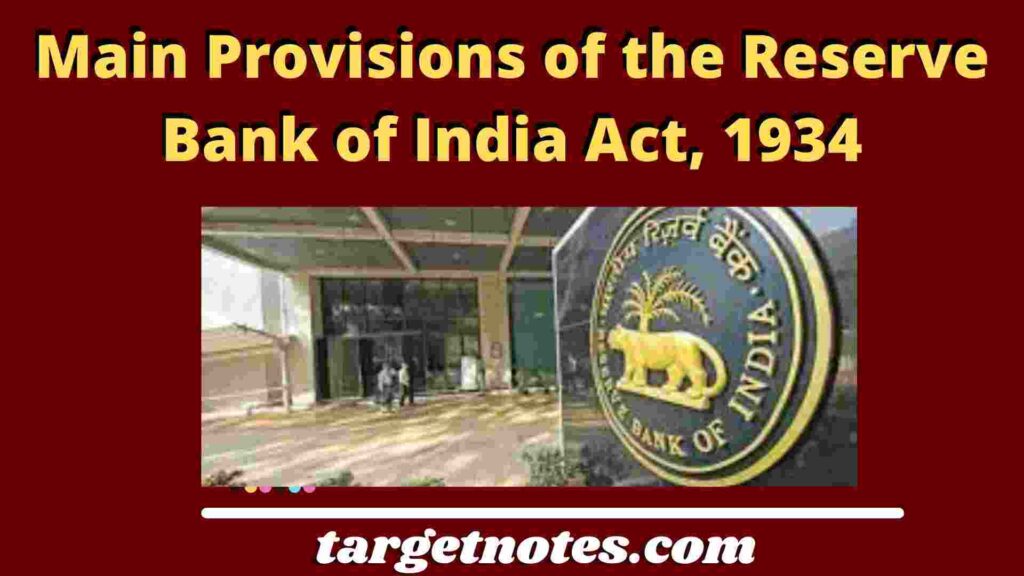
Describe the main provisions of the Reserve Bank of India Act, 1934.
Contents
Main Provisions of the Reserve Bank of India Act, 1934
After the Reserve Bank of India Act, 1934 came into force, the regulation, control and operation of various services e.g. economical, financial and banking services have been amended time to time. As a result the scope of this banking Act have become broader and enhanced with development orientation. The Act includes 5 Chapters, 5 schedules and total 58 Articles. The main provisions of the Act are mentioned as follows:
1. Name, Scope and Date- The name of this Act will be ‘Reserve Bank of India Act, 1934.’ The Act is applicable to the whole India. The date of enforcement of this Act is 1 April, 1935.
2. Section 2 of the Act – The present capital of the Reserve Bank is 5 crore rupees, which is further divided into the share of 5 lacs @ 100 Rs. each. At present all the shares of Reserve Bank have been purchased by Government of India and Reserve Bank is a nationalised institution. But when the Reserve Bank had been established in the year 1935, at that time it was set up as private shareholders bank. At the time of its nationalisation, the capital of Reserve Bank was 5 crore rupees. Divided into the shares of 5 lacs of Rs. 100 each. But on 1 January, 1994 when the Government of India nationalised it, all the shares were transferred to Government of India. The Government of India paid the Rs. 118.62 for each Rs. 100 share.
3. Departments and Branches – According to Section 6 of the Reserve Bank, it can open its branches or agencies at any place in the whole country. It can establish its offices and branches even outside India but for this purpose, the Reserve Bank had to seek the prior approval of the Central Government.
The main offices of the Reserve Bank of India includes:
- Secretarial Department
- Department of Administration
- Department of Accounts and Expenditure
- Premises Department
- Inspection Department
- Legal Department
- Exchange Control Department
- Agricultural Credit Department
- Department of Banking Operations and Development
- Industrial Finance Department
- Department of Non-banking Companies
- Economics Department
- Department of Research and Statistics
- Department of Inspection.
Some important departments can be discussed as under –
1. Agriculture Credit Department – This department formulates the agricultural credit policy of the Reserve Bank and when required also provides agriculture credit facilities to State Government and State Co-operative Banks. It also publishes its report relating to agriculture credit.
2. Legal Department – The legal advisor is the sole incharge of this department which tenders legal advice on various matters referred to it by the departments of the bank. The department refers and interprets the provisions of the Reserve Bank of India Act, the Banking Regulation Act, the Foreign Exchange Management Act, Public Debt Act, the Industrial Disputes Act and various other statutes. This department is also entrusted with the function of drafting legislation or amendments to existing legislation and subordinate legislation. Its functions as the legal advisor to the various associate institutions such as Industrial Development Bank of India, the Agriculture Refinance Corporation, the Unit Trust of India and the Deposit Insurance Corporation.
3. Industrial Finance Department – This department discharges the responsibilities of the Reserve Bank. This department has been divided into four divisions i.e. Operation, Inspection, Planning and Guarantee. The operation division i.e. attends operational and organisational problem of the State Finance Corporations. The Inspection Division conducts inspection of the State Corporation under Section 37-A of the SFC Act, 1951. The Planning Division is responsible mainly for the collection and study of data on the financing of small-scale industries. The Guarantee Division administers credit guarantee scheme. There are four regional offices at Mumbai, Chennai and New Delhi.
4. Research and Statistical Department – The main function of this department is the collection and completion of statistical information relating to the banking and financial activities. The activities have been extended far beyond into the application of sophisticated, statistical and economic methods in the analysis of append economic problems. The empirical research is possible by the economic statistics of right quality and coverage. The application of statistical and econometric technique sharpens the tools of economic analysis. The Department is comprised of four divisions:
- Company finance and flow of funds.
- Data processing,
- Econometric studies and statistical,
- Bulletin, currency report and other publications.
5. Banking Development Department – The main function of this department is to execute the recommendations of rural banking research committee.
6. Department of Banking Operations – This department is divided into supervision, control and development. The supervision department timely inspects the scheduled banks. This department of banking operation performs all the functions relating to Reserve Bank.
7. Department of Non-banking Companies – This department is established to administer the powers conferred in the Reserve Bank Act under the various sections of the Reserve Bank of India Act, 1934. It controls the deposits in the case of non-banking, non-financial companies and the regulation of deposits of non-banking financial companies. It scrutinises these returns and balance sheets of the companies and keeps watch on the compliance of the various provisions by the companies. This department is located in Kolkata.
8. Exchange Control Department – This department was established in 1939 and is entrusted with the responsibility of controlling foreign exchange transactions and to maintain a stable rate of exchange.
9. Exchange Control Department – The establishment of this department was done after the end of second world war on September 1939. The Foreign Exchange Management Act is recently passed by the Government of India. Under this Act, this department was entrusted with the many rights relating to foreign exchange. The functions of the department are Exports, Trade, Licensing and Agency Arrangements, Loans and Overdrafts, Travel, Foreign Currency, Accounts, Statistic, Policy and Co-ordination of Publication.
Apart from its central offices regional departments are –
- Note – Issue Department
- Banking Department
Above can be summarised below.
(i) Note-Issue Department –
This department is concerned with the business relating to note issue and distributing them to the treasuries, sub treasuries and the banking agencies and sub-agencies maintaining currency. This department is divided into two separate departments i.e. the General Department and the Cash Department. The General Department attends to resource operations and Cash Department handles the cash transactions and actual remittances. It also makes payment in respect of cheques drawn on the bank by governments and banks also receives deposits from them.
(ii) Banking Department –
This department was established on 1 July, 1935. This department performs two main functions. This department manages the governmental transactions and governmental debt and with that it also transfers the governmental money.
Secondly, this department also deposits the cash reserves of the scheduled banks and provides them timely aid. This department also performs the functions of clearing house also.
Management- According to Section 8 of the Act, the management of the Reserve Bank is done by a Central Board of Directors comprising 20 members which are as follows:
(a) A Governor and 4 Deputy Governors appointed for the tenure of 5 years by the Government of India and their pay scales are determined by the Central Board of Directors according to the advice of the Central Government.
(b) Four directors from the local boards, are also nominated in the Reserve Bank of India. Amongst these 4 Board of Directors, the Government of India nominates each of the one director to the Central Board whose tenure is of 5 years. If required these directors can be re-nominated by the Central Government for 5 years.
(c) 10 other directors for the period of 4 years are also nominated by the Government of India.
(d) One Government official is also nominated by the Government which can work for any period of time. But this government official do not have the voting right in the Board meeting.
Persons Ineligible for Membership:
According to Section 10, the following individuals cannot be nominated by Government of India for the local and central board.
- An insolvent
- Mentally unfit person
- Government official
- Official working in any bank
- Member of any business organisation or member of Board of Directors of Government Bank.
Withdrawal of Membership
According to Section 11 member of the Board of Directors, whether Central or Local Board can withdraw its membership in the following manner :
- By resignation letter.
- Issuing order through Central Government
- When the Governor or Deputy Governor asks for the resignation.
- If any member remains absent for the three continuous board meetings without leave, then he will be removed.
- When any director of the Reserve Bank or the member of any local board gets elected for the membership of the Parliament or the Legislative Assembly.
Business which the RBI may Transact [Sec. 17] – RBI can transact the following business –
- Accepting deposits from the Central Government, State Governments, local bodies and other persons without interest.
- Sale and purchase of bills of exchange and promissory notes drawn and payable in India.
- Sale and purchase of foreign exchange with schedule banks.
- Providing loan or advances on stock, funds, securities, gold or silver title documents.
Section 18 of the Act provides right of direct discount of certain bill exchange.
Section 20 and 21 provide the central banking functions of the RBI
Right to issue Currency Note (Section 22 to 26(a)] – Reserve Ban of India has monopoly to issue currency notes in India. This function executed by the rate issue department of RBI. Note issued by the Reserve Banks are tender money.
Related Link
- Describe the various types of money
- Dynamic Functions of Money
- Evils or Demerits of Money
- Importance and significance of money in Modern Economy
- Approaches regarding Definitions of Money and its Function
- Money: Meaning, Definitions and features of Money
IMPORTANT LINK
- What is the Exchange Rate System in India?
- Evolution of foreign exchange market in India
- Meaning and importance of export finance.
- Role of Export-Import Bank in Financing India’s Foreign Trade
- How Commercial banks Export Finance to Overseas Importers?
- Explain packing credit in detail?
- What is Post-shipment credit?
- What is Pre-shipment or packing credit?
- Explain Export Credit in India?
- Institutions Providing Finance and Credit Facility for Foreign Trade
- What is Risk Analysis?
- Explain Political risks in detail? and its Types
- What are the types of Risks. Explain in detail?
- Meaning and Types of commercial risks
- How can we minimize foreign trade risks?
- What are Arbitrage operations?
- Difference between Spot Market and Forward Market
- What is spot exchange?
- Agency agreement: Meaning, Features and Advantages
- Functions of Foreign Exchange markets
- structure of Foreign exchange markets
Disclaimer






